
The roofing industry is complex and has a wide range. Different roofs of buildings are composed of different roofing materials. One type of common roofing application is torch down roofing.
What is Torch Down Roofing?
First, let’s go with what torch down roofing is. The official term used for torch down roofing is bitumen roofing. Torch down roofing is a type of roof in which sheets of bitumen are rolled onto the roof and burned using a propane torch. This heating process adheres the bitumen roofing material onto the surface of the roof. By proving the right temperature and conditions, layers can be sealed together and create a water resistance surface.
Torch down roofs have two types, two-layer systems, and three-layer systems.
Which is the Best Type of Torch Down Roofing?
Both two-layer and three-layer systems have a base layer and torch down layer. But a three-layer system has a base layer, a smooth torch down layer, and a granular base layer. The extra layer helps to extend the lifetime of the roofing system and guarantees no leakage.
What are Materials Used in Torch Down Roofing?
Each sheet of torch-down roofing material consists of various membranes piled and adhered together. These are the membrane layers of torch down roofing material:
1. Modified Bitumen
Modified bitumen is the main material used in torch-down roofs. It is highly flexible and provides a secure watertight seal to your roof.
2. Styrene Butadiene Styrene (SBS)
SBS is a type of rubber used in modified bitumen. It is highly flexible and has a low melting point. It is suitable for torch-down roofing and self-adhering roofing systems.
3. Atactic Polypropylene (AP)
AP is a type of plastic used in modified bitumen. It is highly flexible and has a higher melting point than SBS.
4. Granulated Mineral Surface
In a three-layer torch-down roofing system, a granular mineral layer is added with a base layer and torch-down layer. It enhances your roof protection and sealing as well as extends the life span.
5. Thermo-fusible Film
This acts as your first layer of underlayment applied in a torch-down roofing installation.
6. Vapor Barrier
Vapor barriers also work as a thermo-fusible film and protect your roof from moisture.
7. Flashing
In torch down roofing, a self-adhering modified bitumen is applied as the first layer of flashing. After installing this layer, metal flashing is applied above the bitumen layer.
How is Torch Down Roofing Installed?
The following steps will help you gain proper understanding of the installation process of torch down roofing:
- Attach insulation.
- Install moisture barrier.
- Install the overlay board.
- Install the base sheet.
- Install the base sheet.
- Apply metal flashing.
What are the Benefits and Disadvantages of Torch Down Roofing?
If you are deciding to install bitumen torch down roofing there are some pros and cons you should consider.
Benefits of Torch Down Roofing
· Leak Resistance
The best advantage of torch-down roofing is its strong water resistance property. In areas where snow builds up on the roof and damages it, torch-down roofing seems most suitable.
· Flexibility and Durability
The modified bitumen sheets expand and contract with the temperature change. While other roofing materials are rigid and get damaged with temperature changes.
· UV Rays Protection
Torch down roofing protects against UV rays and heat. For the three-layer system, UV rays’ protection is further enhanced. The surface of your torch-down roof can help lower your cooling bill in hot weather.
· Lifespan
The lifespan of torch down roofing is relatively higher than another roofing system. It lasts between 15-20 years.
· Fire Resistance
With adding a granulated mineral layer, torch down roofing becomes high fire-resistive.
· Easy Maintenance
Compared to other roofing, torch-down roofing is easy to maintain. It rolls on and can easily be sealed and the maintenance process is simple and cheap.
Disadvantages of Torch Down Roofing
· Fire Hazard
Torch down roofing is applied with an open flame and, therefore, always poses some level of a fire hazard if misled.
Modified bitumen is a highly non-flammable construction material. But if overheated during the installation period compounds can break down and become flammable. Hire a professional to avoid any disaster.
· Vulnerable to Tears
No doubt torch down roof is highly flexible, but it can’t stand against scratches and tears. If the water-resistance seal is torn, this can compromise the entire roofing structure.
· Precise Installation
Installation of the torch down the roof needs precession and experience. Improper installation leads to roof damage and leaks. For installing a torch down the roof, you need to hire a professional.
· Cost
Torch-down roofing systems are more costly than simple roofing.
Torch down systems provide excellent water resistance and have a lifespan of about 20 years or more. If you want to install torch-down roofing make sure to hire a professional to avoid any risk.






